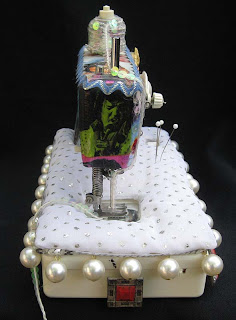One of my specialties is Jewish quilting. I've made scads of matzoh covers for Passover - it would take a month of Passovers to use all of them at a rate of one a day - but here are my two favorites. Both involve delightful trompe l'oeil matzoh fabric. (You can never buy too much!)
Matzoh Cover 1: Flight from the Narrow Places
In the Passover seder, Egypt is called mitzrayim, which can be interpreted as "narrow place." Some say Passover should be viewed as an occasion to plan our escape from personal or communal narrow spaces, whether character flaws (I, for one, need to stop hoarding buttons, beads and fabric), or to save the world from modern plagues like climate change and easily-available semi-automatic weaponry.
For this matzoh cover, I combined that midrash with the traditional American quilt pattern called flying geese. Usually, flying geese triangles are all the same size. In my curvy version, they appear to be flying from a distant tiny point to a spacious area. I drew the design on paper, and then foundation paper-pieced it. (But one could just as easily - or much more easily - do this with fusible applique.)
There's a hand beaded fringe all the way around. The beads near the smallest geese are black - coming from a dark place
and the rest of the beading is blue, except at the widest edge, where it's gold.
It's all machine quilted, And three pockets were added to the back, to tuck in the actual matzot.
Matzoh Cover II: Button Collection
Unlike the previous matzoh cover, I can't really explain this one in any rational way. It involved a lot of color, a lot of buttons,
...and a whole lot of zigzags.
I used the round shape to signify the shmura matzot that some traditional communities prefer to the machine-made square ones. Two more matzot are peeking out from the layers. Satin-stitched zigzags are also emerging.
They're some kind of energy lines. To give the matzoh an authentically bumpy texture, I stitched 3-step zigzags with variegated thread in my machine top.
Perhaps this cover is a comment on how much kinetic energy is required to clean the house and set the table for Passover, let alone to get out of metaphorical Egypt?
Or maybe it means: If, like the ancient Hebrews, I was forced to evacuate my home due to prejudice, or here in Southern California more likely, due to earthquakes, fire, or mudslides - well, in that case I'd definitely want to bring my button, bead and fabric collections with me. But if I didn't have time to pack it all up and flee - I could just pack up these two matzoh covers for consolation.
Whatever you may be celebrating, hope you are having a good day!







































